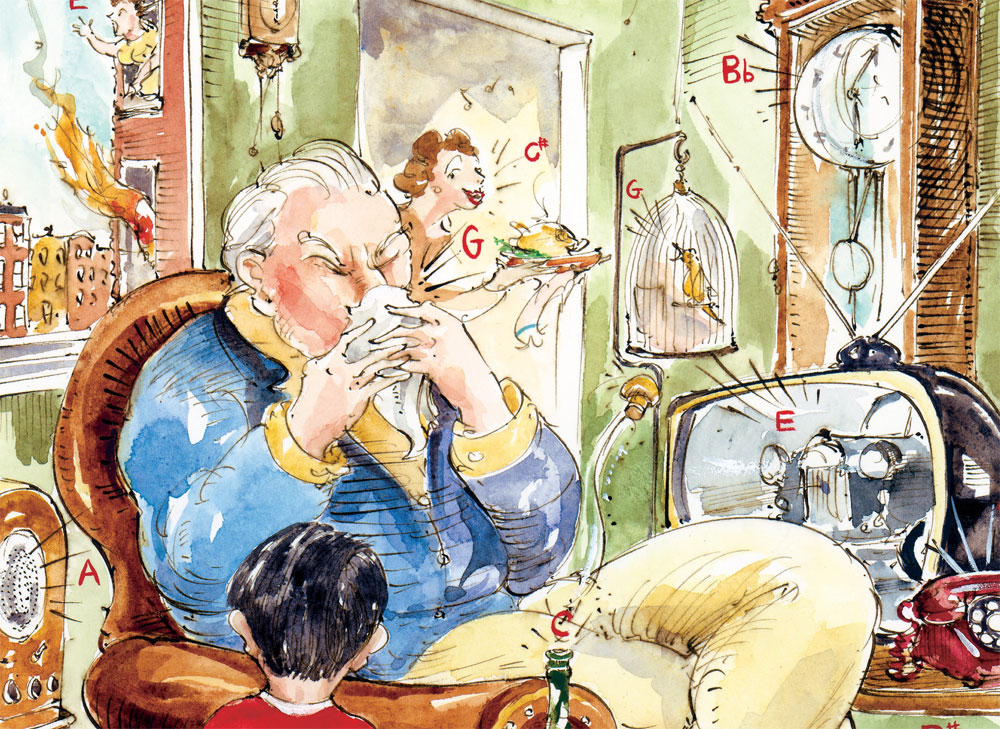"I'm a clinician, I'm a physician, I wear a white coat a lot of the time and I listen to people," the neurologist Oliver Sacks told faculty and students of the Department of Psychiatry on his first day at Columbia in September, during a lecture at the Columbia University Medical Center (CUMC) campus. "I listen to their stories, I imagine their experiences, I try to understand how they react or adapt to experiences produced by some mental or physical change, and I observe behaviors."
In other words, he's also a writer. The author of 10 books, including the bestsellers Awakenings (1973) and The Man Who Mistook His Wife for a Hat (1985), Sacks's quirky, erudite, layperson-friendly stories of neurological phenomena established him as a model of the multidisciplinary ideal.
And so when Gregory Mosher, director of the Arts Initiative at Columbia, approached provost Alan Brinkley about forming a new position — Columbia Artist — that would advance multidisciplinary scholarship at Columbia, he named Sacks as an example of a worthy candidate. The rest was serendipity: Several months later, Mosher and University Professor Eric Kandel were each approached by a common friend of theirs and Sacks who wanted to know if Columbia would be interested in engaging Sacks in some capacity. With the Columbia Artist position in mind, Mosher and Kandel set out to bring Sacks on board.
"We would of course welcome Oliver Sacks to Columbia for his writing alone," says Mosher. "Or his science alone. That he exemplifies so many of Columbia's intellectual and creative goals makes his arrival a cheery event indeed." Now a professor of clinical neurology and clinical psychiatry at CUMC, Sacks will also teach creative writing in the MFA program.
Born in London in 1933, Oliver Sacks grew up in a cultivated family of physicians and scientists. His mother, a surgeon, and his father, a general practitioner, were exceedingly solicitous of their youngest son's curiosity, as recorded in Uncle Tungsten: Memories of a Chemical Boyhood (2001). Sacks went on to earn his medical degree at Oxford University and moved to New York in 1965. A year later, as a consulting neurologist for Beth Abraham Hospital in the Bronx, Sacks treated a group of patients whose bouts with sleeping sickness (encephalitis lethargica) formed the basis of Awakenings, which was later made into a movie starring Robert De Niro and Robin Williams. In addition to his work at local institutions, Sacks also maintains a small private practice in neurology.
If Sacks's reminiscences of childhood in Uncle Tungsten suggest the literary stepson of Marcel Proust and Isaac Asimov, his latest book, Musicophilia: Tales of Music and the Brain, adds a dash of the music-obsessed Thomas Mann. Picking up the thread from the chapter "Reminiscence" — about music and memory — in The Man Who Mistook His Wife for a Hat, the new collection explores the neurological effects of music through the experiences of Sacks's usual array of extraordinary patients.
In this chapter, "Papa Blows His Nose in G: Absolute Pitch," Sacks explores the phenomenon of absolute pitch.
People with absolute pitch can immediately, unthinkingly tell the pitch of any note, without either reflection or comparison with an external standard. They can do this not only with any note they hear, but to any note they imagine or hear in their heads. Indeed, Gordon B., a professional violinist who wrote to me about tinnitus, or ringing in his ears, remarked matter-of-factly that his tinnitus was "a high F-natural." He did not realize, I think, that saying this was in any way unusual; but of the millions of people with tinnitus, probably not one in ten thousand could say what pitch their tinnitus has.
The precision of absolute pitch varies, but it is estimated that most people with it can identify upwards of 70 tones in the middle region of the auditory range, and each of these 70 tones has, for them, a unique and characteristic quality that distinguishes it absolutely from any other note.
The Oxford Companion to Music was a sort of Arabian Nights for me as a boy, an inexhaustible source of musical stories, and it gives many charming examples of absolute pitch. Sir Frederick Ouseley, a former professor of music at Oxford, for example, "was all his life remarkable for his sense of absolute pitch. At five he was able to remark, 'Only think, Papa blows his nose in G.' He would say that it thundered in G or that the wind was whistling in D, or that the clock (with a two-note chime) struck in B minor, and when the assertion was tested it would invariably be found correct." For most of us, such an ability to recognize an exact pitch seems uncanny, almost like another sense, a sense we can never hope to possess, such as infrared or X-ray vision; but for those who are born with absolute pitch, it seems perfectly normal.
The Finnish entomologist Olavi Sotavalta, an expert on the sounds of insects in flight, was greatly assisted in his studies by having absolute pitch for the sound of an insect in flight that is produced by the frequency of its wingbeats. Not content with musical notation, Sotavalta was able to estimate very exact frequencies by ear. The sound pitch made by the moth Plusia gamma approximates a low F-sharp, but Sotavalta could estimate it more precisely as having a frequency of 46 cycles per second. Such an ability, of course, requires not only a remarkable ear, but also a knowledge of the scales and frequencies with which pitch can be correlated.
Yet such a correlation, though immensely impressive, deflects attention from the real wonder of absolute pitch: to those with absolute pitch, every tone, every key seems qualitatively different, each possessing its own "flavor" or "feel," its own character. Those who have absolute pitch often compare it to color — they "hear" G-sharpness as instantly and automatically as we "see" blue. (Indeed, the word "chroma" is sometimes used in musical theory.) While absolute pitch may sound like a delicious extra sense, allowing one to instantly sing or notate any music at its correct pitch, it may cause problems, too. One such problem occurs with the inconstant tuning of musical instruments. Thus the seven-year-old Mozart, comparing his own little violin to that of his friend Schactner, said, "If you have not altered the tuning of your violin since I last played on it, it is half a quarter of a tone flatter than mine here." (So it is related in The Oxford Companion to Music; there are many tales about Mozart's ear, some no doubt apocryphal.) When the composer Michael Torke encountered my own ancient piano, which — still having its original nineteenth-century strings — is not tuned up to the 440 cycles per second standard of modern pianos, he instantly remarked that it was a third of a tone flat. Such an overall sharpness or flatness would not be noticed by someone without absolute pitch, but it can be distressing and even disabling to those who do have it. The Oxford Companion to Music again gives many examples, including one of an eminent pianist who, playing the Moonlight Sonata (a piece which "every schoolgirl plays"), got through it only "with the greatest difficulty" because the piano was tuned to a pitch he was not accustomed to, and he "experienced the distress of playing the piece in one key and hearing it in another."
When people with absolute pitch "hear a familiar piece of music played in the wrong key," Daniel Levitin and Susan Rogers write, "they often become agitated or disturbed. To get a sense of what it is like, imagine going to the produce market and finding that, because of a temporary disorder of visual processing, the bananas all appear orange, the lettuce yellow and the apples purple."
Transposing music from one key to another is something that any competent musician can do easily and almost automatically. But for someone with absolute pitch, each key has its own unique character, and the key in which one has always heard a piece is likely to be felt as the only right one. Transposing a piece of music, for someone with absolute pitch, is analogous to painting a picture with all the wrong colors.
Another difficulty was mentioned to me by the neurologist and musician Steven Frucht, who himself has absolute pitch. He sometimes experiences a certain difficulty in hearing intervals or harmonies because he is so conscious of the chroma of the notes that compose them. If, for example, one plays a C on the piano and the F-sharp above this, he might be so conscious of the C-ness of the C and the F-sharpness of the F-sharp that he fails to notice that they form a tritone, a dissonance which makes most people wince.
Absolute pitch is not necessarily of much importance even to musicians — Mozart had it, but Wagner and Schumann lacked it. But for anyone who has it, the loss of absolute pitch may be felt as a severe privation. This sense of loss was clearly brought out by one of my patients, Frank V., a composer who suffered brain damage from the rupture of an aneurysm of the anterior communicating artery. Frank was highly gifted musically, and had been musically trained since the age of four. He had had absolute pitch as long as he could recall, but now, he said, "it is gone, or it has certainly been eroded." Since absolute pitch was of advantage to him as a musician, he felt its erosion keenly. Originally, he said, he perceived pitches instantly, absolutely, as he perceived colors. No "mental process" was involved, no inference, no reference to other pitches or intervals or scales. This form of absolute pitch had vanished completely; it was, he said, as if he had become "color-blind" in this regard. But as he convalesced from his brain injury, he found that he still possessed reliable pitch memories of certain pieces and certain instruments, and he could use these reference points to infer other pitches though this, in comparison to his "instant" absolute pitch, was a slower process.
It was also, subjectively, entirely different, for previously every note and every key had had a distinctive flavor for him, a character uniquely its own. Now all of this was gone, and there was no longer any real difference, for him, between one key and another.
It seems curious, in a way, that absolute pitch is so rare (it is estimated as occurring in less than one person in 10,000). Why don't all of us hear "G-sharpness" as automatically as we see blue or smell a rose? "The real question concerning absolute pitch," wrote Diana Deutsch et al. in 2004, "is not why some people possess it, but rather why it is not universal. It is as though most people have a syndrome with respect to the labeling of pitches which is like color anomia, in which the patient can recognize colors, and discriminate between them, but cannot associate them with verbal labels."
Deutsch speaks here from personal experience as well. As she wrote to me in a recent letter:
My realization that I had absolute pitch — and that this was unusual — came in the form of a great surprise when I discovered, at age four, that other people had difficulty naming notes out of context. I still remember vividly my shock at discovering that when I played a note on the piano, others had to see what key was being struck in order to name it.
To give you a sense of how strange a lack of absolute pitch appears to those of us who have it, take color naming as an analogy. Suppose you showed someone a red object and asked him to name the color. And suppose he answered, "I can recognize the color, and I can discriminate it from other colors, but I just can't name it." Then you juxtaposed a blue object and named its color, and he responded, "OK, since the second color is blue, the first one must be red." I believe that most people would find this process rather bizarre. Yet, from the perspective of someone with absolute pitch, this is precisely how most people name pitches — they evaluate the relationship between the pitch to be named and another pitch whose name they already know...When I hear a musical note and identify its pitch, much more happens than simply placing its pitch on a point (or in a region) along a continuum. Suppose I hear an F-sharp sounded on the piano. I obtain a strong sense of familiarity for 'F-sharpness' — like the sense one gets when one recognizes a familiar face. The pitch is bundled in with other attributes of the note — its timbre (very importantly), its loudness, and so on. I believe that, at least for some people with absolute pitch, notes are perceived and remembered in a way that is far more concrete than for those who do not possess this faculty.
Absolute pitch is of special interest because it exemplifies a whole other realm of perception, of qualia, something that most of us cannot even begin to imagine because it is an isolated ability with little inherent connection to musicality or anything else, and because it shows how genes and experience can interact in its production.
It has long been clear anecdotally that absolute pitch is more common in musicians than in the general public, and this has been confirmed by large-scale studies. Among musicians, absolute pitch is more common in those who have had musical training from an early age. But the correlation does not always hold; many gifted musicians fail to develop absolute pitch, despite intensive early training. It is prevalent in certain families, but is this because of a genetic component or because some families provide a richer musical environment? There is a striking association of absolute pitch with early blindness (some studies estimate that about 50 percent of children born blind or blinded in infancy have absolute pitch).
One of the most intriguing correlations occurs between absolute pitch and linguistic background. For the past few years, Diana Deutsch and her colleagues have studied such correlations in greater detail, and they observed that "native speakers of Vietnamese and Mandarin show very precise absolute pitch in reading lists of words"; most of these subjects showed variation of a quarter tone or less. Deutsch and her researchers have also showed very dramatic differences between the incidence of absolute pitch in two populations of first-year music students: one at the Eastman School of Music in Rochester, New York, and the other at the Central Conservatory of Music in Beijing. "For students who had begun musical training between ages four and five," they wrote, "approximately 60 percent of the Chinese students met the criterion for absolute pitch, while only about 14 percent of the U.S. nontone language speakers met the criterion." For those who had begun musical training at age six or seven, the numbers in both groups were correspondingly lower, about 55 percent and 6 percent. And for students who had begun musical training later still, at age eight or nine, "roughly 42 percent of the Chinese students met the criterion while none of the U.S. nontone language speakers did so." There were no differences between genders in either group.
This striking discrepancy led Deutsch to conjecture that "if given the opportunity, infants can acquire absolute pitch as a feature of speech, which can then carry over to music." For speakers of a nontonal language such as English, they felt, "the acquisition of absolute pitch during music training is analogous to learning the tones of a second language." They observed that there was a critical period for the development of absolute pitch, before the age of eight or so — roughly the same age at which children find it much more difficult to learn the phonemes of another language (and thus to speak a second language with a native accent). Deutsch and company suggested, therefore, that all infants might have the potential for acquiring absolute pitch, which could perhaps be "realized by enabling infants to associate pitches with verbal labels during the critical period" for language acquisition. (They did not exclude the possibility, nonetheless, that genetic differences might be important, too.)
The neural correlates of absolute pitch have been illuminated by comparing the brains of musicians with, and without, absolute pitch using a refined form of structural brain imaging (MRI morphometry),and by functional imaging of the brain as subjects identify musical tones and intervals. A 1995 paper by Gottfried Schlaug and his colleagues showed that in musicians with absolute pitch (but not in musicians without) there was an exaggerated asymmetry between the volumes of the right and left planum temporale, structures in the brain that are important for the perception of speech and music. Similar asymmetries in the size and activity of the planum temporale have been shown in other people with absolute pitch.
Absolute pitch is not just a matter of pitch perception. People with absolute pitch must be able not only to perceive precise pitch differences, but also to label them, to line them up with the notes or names of a musical scale. It is this ability that Frank V. lost with the frontal lobe damage caused by the rupture of his cerebral aneurysm. The additional cerebral mechanisms required to correlate pitch and label are in the frontal lobes, and this, too, can be seen in functional MRI studies; thus, if someone with absolute pitch is asked to name tones or intervals, MRIs will show focal activation in certain associative areas of the frontal cortex. In those with relative pitch, this region is activated only when naming intervals.
While such categorical labeling is learned by all people with absolute pitch, it is not clear that this excludes a prior categorical perception of pitch that is not dependent on association and learning. And the insistence of many with absolute pitch on the unique perceptual qualities of every pitch — its "color" or "chroma" — suggests that before the learning of categorical labels, there may be a purely perceptual categorization.
Jenny Saffran and Gregory Griepentrog at the University of Wisconsin compared eight-month-old infants to adults with and without musical training in a learning test of tone sequences. The infants, they found, relied much more heavily on absolute pitch cues; the adults, on relative pitch cues. This suggested to them that absolute pitch may be universal and highly adaptive in infancy but becomes maladaptive later and is therefore lost. "Infants limited to grouping melodies by perfect pitches," they pointed out, "would never discover that the songs they hear are the same when sung in different keys or that words spoken at different fundamental frequencies are the same." In particular, they argued, the development of language necessitates the inhibition of absolute pitch, and only unusual conditions enable it to be retained. (The acquisition of a tonal language may be one of the "unusual conditions" that lead to the retention and perhaps heightening of absolute pitch.)
Deutsch and her colleagues, in their 2006 paper, suggested that their work not only has "implications for the issues of modularity in the processing of speech and music...[but] of the evolutionary origin" of both. In particular, they see absolute pitch, whatever its subsequent vicissitudes, as having been crucial to the origins of both speech and music. In his book The Singing Neanderthals: The Origins of Music, Language, Mind and Body, Steven Mithen takes this idea further, suggesting that music and language have a common origin, and that a sort of combined protomusic-cum-protolanguage was characteristic of the Neanderthal mind. This sort of singing language of meanings, without individual words as we understand them, he calls Hmmm (for holistic-mimetic-musical-multimodal), and it depended, he speculates, on a conglomeration of isolated skills, including mimetic abilities and absolute pitch.
With the development of "a compositional language and syntactic rules," Mithen writes, "allowing an infinite number of things to be said, in contrast to the limited number of phrases that Hmmm allowed...the brains of infants and children would have developed in a new fashion, one consequence of which would have been the loss of perfect pitch in the majority of individuals, and a diminution of musical abilities." We have little evidence as yet for this audacious hypothesis, but it is a tantalizing one.
I was once told of an isolated valley somewhere in the Pacific where all the inhabitants have absolute pitch. I like to imagine that such a place is populated by an ancient tribe that has remained in the state of Mithen's Neanderthals, with a host of exquisite mimetic abilities and communicating in a protolanguage as musical as it is lexical. But I suspect that the Valley of Absolute Pitch does not exist, except as a lovely, Edenic metaphor, or perhaps some sort of collective memory of a more musical past.



